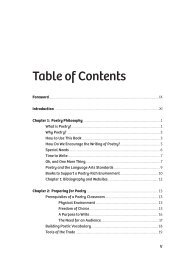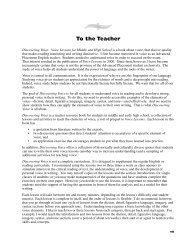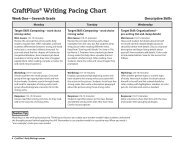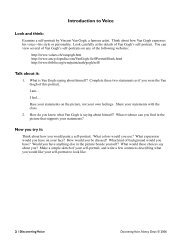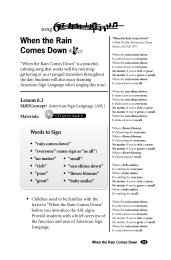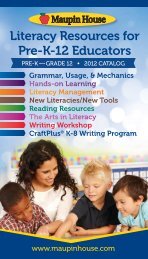Building a Writing Community Teacher Study Guide - Maupin House ...
Building a Writing Community Teacher Study Guide - Maupin House ...
Building a Writing Community Teacher Study Guide - Maupin House ...
You also want an ePaper? Increase the reach of your titles
YUMPU automatically turns print PDFs into web optimized ePapers that Google loves.
<strong>Building</strong> a <strong>Writing</strong> <strong>Community</strong>:<br />
A Practical <strong>Guide</strong><br />
By Marcia Freeman<br />
<strong>Maupin</strong> <strong>House</strong> Publishing<br />
<strong>Building</strong> a <strong>Writing</strong> <strong>Community</strong> guides teachers in developing the writer’s craft in<br />
students. Marcia Freeman explains that the process is what writers do, but the<br />
craft is what writers know. This book defines target skills and helps teachers to<br />
know how to teach these skills in the writing workshop model. <strong>Building</strong> a <strong>Writing</strong><br />
<strong>Community</strong> fosters writing proficiency that will have a positive effect on reading<br />
comprehension and achievement across the curriculum.<br />
<strong>Building</strong> a <strong>Writing</strong> <strong>Community</strong> is one of the core books used in the CraftPlus K-8<br />
<strong>Writing</strong> Program and Staff Development Resource. Teaching the Youngest<br />
Writers is also available as a resource for working with emergent writers.<br />
About the <strong>Study</strong> <strong>Guide</strong><br />
This guide is designed to facilitate professional development in a collegial book<br />
study atmosphere. Five professional development sessions include discussion<br />
points, guiding questions, workshop activities, and classroom applications. To<br />
create a successful professional development experience, consider the following<br />
tips:<br />
• Before you begin, seek input about teacher schedules and preferences.<br />
Try to arrange your professional development so that participants will be<br />
able to attend every session.<br />
• Provide copies of <strong>Building</strong> a <strong>Writing</strong> <strong>Community</strong> for all participants.<br />
Meaningful application of the skills and activities discussed at each<br />
meeting depends upon access to the resource between meetings.<br />
• Provide discussion questions ahead of time and encourage participants to<br />
become familiar with the material covered in each session prior to the<br />
meeting.<br />
• Provide time between each meeting session to allow teachers the<br />
opportunity to apply the skills and be prepared to share their successes<br />
and challenges in implementation.<br />
• At each meeting, allow for discussion before beginning the planned<br />
workshop activities. <strong>Teacher</strong>s will gain understanding by articulating their<br />
successes and challenges faced when implementing the skills.
Session One<br />
Introduction, The Classroom Daily <strong>Writing</strong> Workshop, Prewriting: Chapters I-III<br />
Guiding Quote:<br />
“Our job, as teachers of the craft, is to help students see that written text has two<br />
layers: the content (the material presented, and the craft (how the author<br />
conveyed the meaning and engaged the reader). Gifted writers may recognize<br />
the craft intuitively, but the rest of us need to be taught it.” (page 7)<br />
Discussion Questions:<br />
1. What materials and resources are necessary to implement writing<br />
workshop?<br />
2. What is a target skill? How do I know what skills to teach my students?<br />
3. What are some of the management techniques to make the writing<br />
workshop effective and to provide structure?<br />
4. What is prewriting and why is it important?<br />
Workshop Activity:<br />
Webbing after Gathering Data or Brainstorming<br />
Prior to the lesson: photocopy reproducibles #5 and #6 found in the appendix in<br />
the back of the book.<br />
1. Follow the lesson plan presented on pages 51-52.<br />
2. Discuss the value of each type of prewriting and how it can help the<br />
drafting process.<br />
3. Divide the participants into four groups. Assign each group one of the<br />
following topics: environment and management, materials, daily writing,<br />
target skills, and the vocabulary of writers.<br />
4. Encourage the groups to find key ideas about their topic and be prepared<br />
to share with the group.<br />
Classroom Implementation:<br />
Give students the opportunity to think and talk about topics. Survey the lessons<br />
in these chapters and plan for instruction. <strong>Guide</strong> students in the prewriting<br />
process by implementing one of the suggested prewriting activities.<br />
Looking Ahead:<br />
Be prepared to discuss the successes and challenges of implementing these<br />
lessons. Encourage teachers to bring student samples to the next session to<br />
facilitate discussion.
Session Two<br />
Drafting, Response, Revision: Chapters IV-VI<br />
Guiding Quote:<br />
“Young writers need to know that their drafts are just one step in the process of<br />
gathering and presenting their thoughts about a given topic. A rough draft<br />
represents a starting place. If is constructed as a document with lots of room to<br />
add and move text, then the successive stages of response, revision, editing,<br />
and publishing will be much easier.” (page 64)<br />
Discussion Questions:<br />
1. What are some of the most effective techniques to help writers during the<br />
drafting process?<br />
2. What are some response strategies and why are they effective?<br />
3. How does conferencing help a writer? What can a teacher do to effectively<br />
facilitate the conferencing process?<br />
4. How does the book define revision? What are some of the techniques<br />
used to assist writers in the process of revision?<br />
Workshop Activity:<br />
1. Divide participants into three groups. Assign each group to one of the<br />
following chapters: Drafting, Response, or Revision. Have each group<br />
read and discuss the key ideas and strategies.<br />
2. Have each group report on their topic. Encourage participants to share<br />
any management strategies, activities, and content necessary for effective<br />
implementation.<br />
3. Direct participants to select at least one idea, activity, or target skill to use<br />
with their students based on the writing sample from the previous session.<br />
Classroom Implementation:<br />
Plan for further needs assessment and progress monitoring. Identify target skills<br />
appropriate for selected grade level and student development. Facilitate the use<br />
of one new strategy or idea.<br />
Looking Ahead:<br />
Be prepared to discuss the successes and challenges of implementing the<br />
activities or lessons. Encourage teachers to bring student samples to the next<br />
session to facilitate discussion.
Session Three<br />
Editing and Publishing: Chapters VII-VIII<br />
Guiding Quote:<br />
“Editing comes after revision and before publishing. Only about 30% or writing in<br />
your classroom writing workshop needs to be edited. You and your young writers<br />
should determine how much and how often work should be published; 10% is<br />
sufficient.”<br />
Discussion Questions:<br />
1. Why is editing an important part of the writing process?<br />
2. What is the difference between revision and editing?<br />
3. Discuss some of the models for editing that are effective in the writing<br />
workshop process?<br />
4. Why do students need to publish their writing? What are some of the<br />
suggested modes for published work?<br />
Workshop Activity:<br />
Model Lesson: Class Edit Model<br />
Prior to the lesson: Photocopy reproducible #14 for each participant. If possible,<br />
create a transparency of the sample to model the lesson.<br />
1. Follow the lesson plan for Class Model Edit on page 96.<br />
2. Discuss the benefits of this lesson and how it could be modified for future<br />
use.<br />
3. Review the procedures for editing by ear on page 98. Discuss how this<br />
strategy would meet the needs of student writers.<br />
4. In small groups, read the information about publishing student work and<br />
be prepared to share key ideas with the whole group.<br />
Classroom Implementation:<br />
Review the various techniques for editing and publishing student writing. Survey<br />
the lessons and activities and develop a plan for instruction.<br />
Looking Ahead:<br />
Be prepared to discuss the successes and challenges of implementing the<br />
activities or lessons. Encourage teachers to bring student samples to the next<br />
session to facilitate discussion.
Session Four<br />
<strong>Writing</strong> Craft, Narrative <strong>Writing</strong>, Expository <strong>Writing</strong>, and Persuasive <strong>Writing</strong>:<br />
Chapters IX-XI<br />
Guiding Quote:<br />
“Writers, like scientists, artists, philosophers, and comedians are observers of the<br />
world. They notice and record their observations enlightening and entertaining<br />
the rest of us.” (page 126)<br />
Discussion Questions:<br />
1. What are composing skills and why are they important?<br />
2. What are some of the major characteristics and techniques associated<br />
with narrative writing?<br />
3. What are the similarities and differences between narrative and expository<br />
writing?<br />
4. What are the three components of a persuasive piece of writing?<br />
Workshop Activity:<br />
1. Divide participants into four groups. Assign each group one of the<br />
following topics: writing craft, narrative writing, expository writing, and<br />
persuasive writing. Have each group read and discuss the assigned<br />
chapter and identify key ideas and strategies. If possible, identify<br />
resources or professional books available that may support each part of<br />
the process.<br />
2. Allow each group to present a brief overview of their assigned topic<br />
identifying specific tips for implementation and any known resources<br />
available.<br />
3. Identify any challenges or barriers that need to be overcome in order to<br />
successfully implement a lesson or idea.<br />
Classroom Implementation:<br />
Choose a particular type of writing and assist students using the writing<br />
workshop model. Implement at least one new idea or strategy from the chapters.<br />
Looking Ahead:<br />
Be prepared to discuss the successes and challenges of implementing the<br />
activities or lessons. Encourage teachers to bring student samples to the next<br />
session to facilitate discussion.
Session Five<br />
Poetry, Evaluation, Assessment, and Portfolios, Meeting Common Challenges:<br />
Chapters XII-XIV<br />
Guiding Quote:<br />
“Do not evaluate and grade every piece of writing a student undertakes. That will<br />
inevitably turn off the flow of writing you are trying to achieve in your classroom<br />
writing community. Young writers need a good deal of practice and opportunity to<br />
experiment and take risks.” (page 187)<br />
Discussion Questions:<br />
1. What are literary devices? How can students use these devices when they<br />
are working with poetry?<br />
2. How do you evaluate students to ensure they are making adequate<br />
progress?<br />
3. What types of documents should be included in a student writing portfolio?<br />
4. What are some of the common challenges teachers face when<br />
implementing the writing workshop model?<br />
Workshop Activity:<br />
1. As a group, brainstorm to determine which components make a piece of<br />
writing good. Make a list and entertain all suggestions.<br />
2. Direct participants to turn to page 195. Review the list and add any<br />
additional ideas to the chart. Explain to participants this is an effective way<br />
to determine where students are currently focused and where they are in<br />
their development.<br />
3. Read the common challenges and suggestions for how to handle those<br />
challenges. Discuss any additional challenges and use the book as a<br />
resource to determine how to respond. Encourage teachers to be<br />
proactive and set clear expectations for students.<br />
4. Review the bibliography of resources on pages 40, 137, and 185. Identify<br />
resources owned by faculty members or available in your school’s<br />
professional library.<br />
Classroom Implementation:<br />
Direct teachers to plan implementation strategies, continue progress monitoring,<br />
and participate in collaborative lesson planning. Encourage teachers to continue<br />
to support each other and use the book as a resource.<br />
Looking Ahead:<br />
Identify desired resources and materials not currently available at your site and<br />
explore funding sources you can use to acquire these resources.



